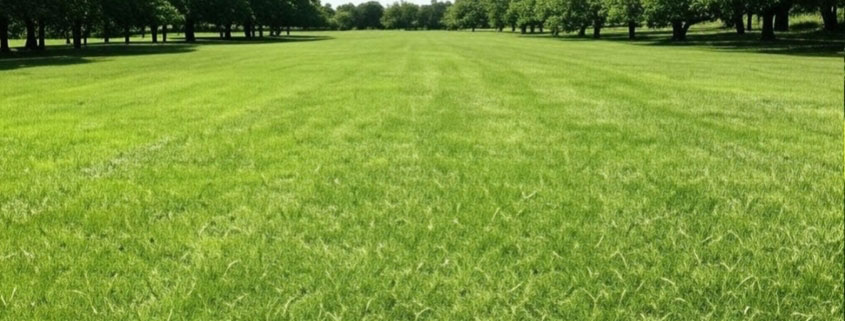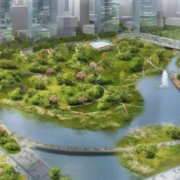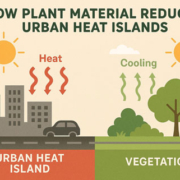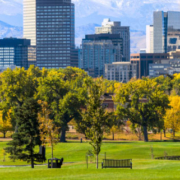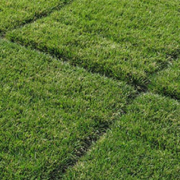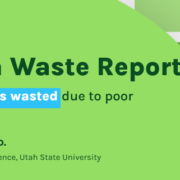The Truth About Grass’s Impact on Water Use
“Grass lawns are the biggest water waster in the West!”
“Lawns don’t provide any ecological functions or benefits. Why do we have them?”
Research Highlights
- Turfgrass provides a broad spectrum of ecosystem services that contribute significantly to environmental quality and resilience in urban landscapes.
- Significant water savings are possible when low-input, drought-tolerant turfgrass varieties are used in conjunction with smart irrigation technologies.
- Turfgrass, when properly selected and managed, can use less water than commonly assumed—sometimes performing better than poorly maintained xeriscapes.
“Maintaining lush, green lawns in dry climates promotes unsustainable landscaping practices!”
These statements−or similar versions of them−have become increasingly common in drought-prone states like Nevada, California, and Arizona where traditional turfgrass lawns may be viewed as incompatible with sustainable water management. Critics point to the high water demands of certain species and widespread inefficiencies in irrigation systems as proof that turfgrass must go.
And while it’s true that poorly managed grasses can require a great deal of water, not all grasses are created equal, and not all lawns are wasteful of water resources. Emerging research and real-world data show that significant water savings are possible when low-input, drought-tolerant turfgrass varieties are used in conjunction with smart irrigation technologies (Sun et al., 2012; Braun et al., 2024). And, in some cases, modern turfgrass systems even outperform so-called “xeriscapes” when designed and maintained correctly.
Today, advancements in turfgrass breeding programs, state-of-the-art irrigation technologies, and modern approaches to landscape design are challenging the idea that grasses are inherently wasteful of water and provide little in the way of environmental benefit. This is not to say that grasses should cover every landscape in every situation. Rather that turfgrasses can offer some solutions to modern environmental challenges and are not always the problem.
The Origins of Grass’s Water-Intensive Reputation
Grass’s reputation as a water-wasting villain stems largely from its historical use and cultural symbolism in American landscapes. Versions of the modern lawn first appeared in American landscapes in the 1700s when influential landowners adopted the idea from European landscapes. In Europe, lawns were a privilege of the wealth and social status that came with land ownership and prominent figures like George Washington and Thomas Jefferson designed their properties to emulate English country estates.
Lawns remained confined to the properties of wealthy landowners until the late 1860’s when the first lawn mowers were patented in the U.S. Prior to that, grass was cut with a scythe or grazed by sheep or cattle (if it was cut down at all), but lawn mowers simplified the process of lawn maintenance.
Following World War II, the federal government helped facilitate the rise of suburbia by underwriting suburban development so that people would move out of cities and begin to populate the spine of the new interstate highway system (also funded by the federal government) (Gabriel, 2022). And residents of suburbia demanded lush, uniform lawns—often made up of cool-season grasses like Kentucky bluegrass—which were well-adapted to cool, wet climates but often required frequent irrigation in arid and semi-arid regions (Dubner, 2017).
These grasses became associated with social status, curb appeal, and responsible homeownership, reinforcing their widespread use despite their lack of suitability in some regions. Compounding the issue, traditional irrigation systems—often poorly designed or maintained—could be inefficient, leading to runoff, evaporation, and excessive use.
Today, lawns are deeply ingrained in American culture and cover large areas across the country. Studies have shown, however, that residential landscape irrigation often exceeds plant water needs by as much as 20-60%, especially in landscapes without “smart” irrigation control or proper irrigation scheduling (Kjelgren et al., 2000).
As drought has become more common and severe over time, the perceived mismatch between maintaining a home lawn and being environmentally responsible has led to intense public scrutiny. Media narratives and conservation campaigns have popularized slogans like “Lose Your Lawn” and “Goodbye Grass” have called for turfgrass removal as a simple solution to water resource challenges. And while these efforts raise awareness, they also oversimplify the issue and often ignore the scientific advances in turfgrass breeding programs, state-of-the-art irrigation technologies, and modern approaches to landscape design that lead to water-efficient landscapes.
How Much Water Does Grass Actually Use?
The amount of water grass requires depends on the species and variety being grown, local climate, and many other aspects of how it’s managed. In arid and semi-arid regions, older varieties of cool-season grasses—such as Kentucky bluegrass—can require up to 30–50 inches of water per year to remain healthy and green (Sun et al., 2012). However, studies evaluating before-and-after scenarios of turfgrass removal programs show mixed results. For instance, southern California data from the Metropolitan Water District reported an average 24% reduction in water use following turf removal, but in some cases, savings were less due to replacement landscapes still requiring irrigation (Chesnutt, 2008).
Research has also shown that water use varies widely across landscape types (Sun et al., 2012). And turfgrass, when properly selected and managed, can use less water than commonly assumed—sometimes performing better than non-irrigated hardscapes or poorly maintained xeriscapes that accumulate heat and require regular washing or dust control.
A key factor is overwatering. Homeowners frequently apply 20–60% more water than grasses require due to poorly maintained irrigation systems, improper irrigation scheduling, and lack of knowledge regarding plant water requirements (Kjelgren et al., 2000). All this is to say that grass isn’t necessarily the problem—it may be the irrigation system or the irrigator that doesn’t understand plant water requirements and efficient approaches to irrigation. When smart irrigation technologies are combined with water-efficient grasses, grasses can be both functional and water-efficient.
The Rise of Resource-Efficient Turfgrass Varieties
In the mid-20th century, turfgrass breeding programs primarily focused on turfgrass aesthetics like color and density. Traffic tolerance, mowing quality, and water requirements were also important breeding considerations (Baxter and Schwartz, 2018). By the 1980s, growing concerns about drought and water use in urban landscapes prompted an increased focus on breeding turfgrass varieties with reduced irrigation requirements and better drought tolerance (Kenna and Petrovsky, 2024.
This shift was largely driven by research at Texas A&M University, Oklahoma State University, the University of California-Riverside, and the University of Georgia, among others, where field trials of new grass cultivars developed in traditional breeding programs began. Cool-season grasses like Kentucky bluegrass and tall fescue and warm-season grasses like buffalograss, bermudagrass, and zoysiagrass were the primary species considered, and the focus was on reducing water requirements and increasing drought and heat tolerance.
The United States Department of Agriculture (USDA) and members of the turfgrass industry have also worked to develop new turfgrass cultivars that balance performance and functionality with sustainability, recognizing turfgrass’s role in urban ecosystems. In more recent years, this work has been accomplished using the latest molecular tools and precision genetic phenotyping to accelerate the development of drought tolerant turfgrass varieties and that work continues today.
Smarter Irrigation Changes the Water Efficiency Conversation
Improved turfgrass varieties are just one piece of the landscape water conservation puzzle. Irrigation systems and technologies are equally if not more important. Advances in irrigation technologies such as “smart” or weather-based irrigation control, soil moisture-based irrigation control, pressure regulation, and multi-stream multi-trajectory (MSMT) sprinkler nozzles have dramatically improved landscape water use efficiency and have also improved plant health by preventing overwatering.
“Smart” or weather-based irrigation controllers use local weather conditions to automatically adjust watering schedules, irrigating appropriately while preventing overwatering during rainy periods and reducing irrigation during cool or humid conditions (Cardenas-Lailhacar et al., 2010). Similarly, soil moisture sensor-based irrigation prevents irrigation when the soil already has adequate plant-available water, saving up to 50% compared to conventional timers (Dukes, 2012).
MSMT nozzles, such as Hunter Industries’ MP Rotator, distribute water in slower, more uniform streams with larger water droplets, allowing better soil infiltration and reducing runoff—particularly on slopes or compacted soils (Solomon et al., 2007). Water pressure is the most important variable in irrigation systems and pressure-regulation (sprinkler bodies, valves, and regulators) keep operating water pressure within optimal ranges, maintaining optimal performance while reducing misting and evaporation losses.
Even the best equipment, however, requires good design and regular maintenance. Landscape irrigation audits conducted through the Utah State University Water Check Program have revealed that many residential irrigation systems are overwatering by 30–60% due to issues like poor zoning, broken sprinkler heads, or inefficient scheduling. Yet, with basic adjustments and equipment upgrades, participants routinely see 20–30% water savings (Aveek et al., 2023).
Ultimately, smarter irrigation technologies—along with proper irrigation design and maintenance—represent one of the most effective strategies for achieving meaningful, lasting water conservation in urban landscapes.
The Environmental Services of Turfgrass
Turfgrasses provide a broad spectrum of ecosystem services that contribute significantly to environmental quality and resilience in urban landscapes. As dense, living groundcovers, they reduce soil erosion, enhance stormwater infiltration, and filter runoff to improve water quality in the built environment (Beard & Green, 1994; Braun et al., 2024).
Turfgrass root systems also act as natural biofilters, capturing pollutants like excessive nutrients, heavy metals, and pesticides before they reach and contaminate water bodies. Additionally, turfgrasses cool urban microclimates through evapotranspiration, reducing surface temperatures and helping to mitigate the urban heat island (UHI) effect (Shashua-Bar et al., 2009; Braun et al., 2024). Regarding UHI, studies have shown that turfgrass-covered surfaces can be up to 53°F cooler than impervious surfaces like asphalt or concrete and up to 69°F cooler than artificial turfgrass surfaces (Yilmaz et al., 2008; Devitt et al., 2007).
Turfgrass soil systems also sequester carbon, with managed lawns storing between 0.5–1.0 Mg C ha⁻¹ yr⁻¹ (Qian & Follett, 2010). And while turfgrass is often criticized for excessive water use, especially in arid climates, Braun et al. (2024) argue that modern turfgrass cultivars and improved management practices—such as smart irrigation technologies and appropriate species selection—have greatly enhanced the sustainability of turf in the urban landscape.
Choosing and managing turfgrass lawns appropriately both enhances recreational and visual appeal and provides essential ecological benefits, making it a valuable component of sustainable green infrastructure.
Rethinking Turfgrass Removal Programs
In response to growing concerns over water scarcity, some municipalities have implemented turf removal policies and programs that incentivize the removal of turfgrass with the goal of saving water. While well-intentioned, such broad approaches can lead to unintended negative environmental and social consequences.
Removing turfgrass without careful planning and management has resulted in tree death and some states have created exceptions in their regulations for turfgrass growing under trees as a result. California’s Assembly Bill 1572, for example, makes such an exception. In Utah, the Localscapes™ program recognizes that landscapes need gathering areas and that turfgrasses are a good option for these areas. Turfgrass removal can also exacerbate the UHI effects, as hardscapes and synthetic materials retain and radiate heat more than vegetated surfaces (Yilmaz et al., 2008; Wilcox et al., 2024).
Additionally, turfgrass removal can contribute to a loss of biodiversity, especially when replaced with gravel or artificial turf that provides little habitat or ecological function (Braun et al., 2024). It may also reduce access to recreational green space, disproportionately impacting communities with limited park infrastructure.
To avoid these pitfalls, more nuanced, site-specific policies that focus on promoting water-efficient turf varieties and integrating turfgrass into appropriate landscape design is needed. Warm-season grasses like hybrid bermudagrasses, zoysiagrasses, and buffalograss, for example, have demonstrated significantly lower water use than other species while maintaining ecological and recreational value (Qian and Engelke, 1999).
Focusing on turfgrass removal as a preferred approach to landscape water conservation is simple, but not necessarily effective. Instead, sustainable landscape design should emphasize a “right plant, right place” approach in which well-adapted turfgrasses have a role. This approach conserves water while preserving the valuable ecosystem services that turfgrasses provide.
Conclusion
Excessive irrigation of turfgrass has contributed to the perception of turf as a water-wasting villain. However, research has shown that choosing regionally appropriate turfgrass varieties, implementing efficient irrigation technologies, and thoughtfully designing landscapes, turfgrass can be a sustainable and multifunctional component of water-wise landscapes.
Rather than removing turf indiscriminately, a more nuanced approach that embraces innovation and science-based solutions will both save water and maintain environmental benefits. It’s time to rethink the role of turfgrass—not as a scapegoat—but as a smart, adaptable landscaping choice and another tool in the landscape water conservation toolbox.
References
Aveek, M., D.E. Rosenberg, C. Bastidas, J.S. Horsburgh, B.A. Lane. K. Kopp, P. Mayer and J. Fazio. 2023. Increasing the Impact of Utah State University’s Extension Water Check Program With 5-Second Metering. Reports. Paper 681. https://digitalcommons.usu.edu/water_rep/681.
Baxter, L.L. and B.M. Schwartz. 2018. History of bermudagrass turfgrass breeding research in Tifton, GA. HortScience 53(11):1560-1561.
Braun, R.C., P. Mandal, E. Nwachukwu and A. Stanton. 2024. The role of turfgrasses in environmental protection and their benefits to humans: Thirty years later. Crop Science 64:2909-2944.
Cardenas-Lailhacar, B., M.D. Dukes and G.L. Miller. 2010. Sensor-based automation of irrigation on bermudagrass during dry weather conditions. Journal of Irrigation and Drainage Engineering 136(3):184–193.
Chesnutt, T.W. 2008. California Urban Water Conservation Council Turf Removal Project. A&N Technical Services, Inc.
Devitt, D.A., M.H. Young, M. Baghouz and B.M. Bird. 2007. Surface temperature, heat loading and spectral reflectance of artificial turfgrass. Journal of Turfgrass and Sports Surface Science 83:68-82.
Dubner, S.J. 2017. How stupid is our obsession with lawns? Audio podcast. Season 6, Episode 44. Freakonomics Radio.
Dukes, M.D. 2012. Water conservation potential of smart irrigation controllers. HortTechnology 22(3):331–337.
Gabriel, A. 2022. How lawns became a status symbol in America. Retrieved April 1, 2025. https://www.foxweather.com/lifestyle/lawns-history-status-symbol-america?utm_source=chatgpt.com.
Kenna, M. and J. Petrovsky. 2024. A turfgrass timeline: The history of bermudagrass breeding. Green Section Record 62(03). Retrieved April 7, 2025. https://www.usga.org/content/usga/home-page/course-care/green-section-record/62/issue-03/a-turfgrass-timeline–the-history-of-bermudagrass-breeding-.html?utm_source=chatgpt.com.
Kjelgren, R., L. Rupp and D. Kilgren. 2000. Water conservation in urban landscapes. HortScience 35(6):1037-1040.
Qian, Y.L. and M.C. Engelke. 1999. Performance of five turfgrasses under linear gradient irrigation. HortScience 34(5): 893-896.
Shashua-Bar, L., D. Pearlmutter and E. Erell. 2009. The cooling efficiency of urban landscape strategies. Landscape and Urban Planning 92:179-186.
Solomon, K.H., J.A. Kissinger, G.P. Farrens and J. Borneman. 2007. Performance and water conservation potential of multi-stream, multi-trajectory rotating sprinklers for landscape irrigation. Applied Engineering in Agriculture 23(2), 153–163.
Sun, H., K. Kopp and R. Kjelgren. 2012. Water-efficient urban landscapes: Integrating different water use categorizations and plant types. HortScience 47(2):254-259.
Yilmaz, H. S. Toy, M.a. Irmak, S. Yilmaz, and Y. Bulut. 2008. Determination of temperature differences between asphalt concrete soil and grass surfaces of the City of Erzurum, Turkey. Atmósfera 21(2):135-146.

